Pim de Haan
A Lorentz-Equivariant Transformer for All of the LHC
Nov 01, 2024Abstract:We show that the Lorentz-Equivariant Geometric Algebra Transformer (L-GATr) yields state-of-the-art performance for a wide range of machine learning tasks at the Large Hadron Collider. L-GATr represents data in a geometric algebra over space-time and is equivariant under Lorentz transformations. The underlying architecture is a versatile and scalable transformer, which is able to break symmetries if needed. We demonstrate the power of L-GATr for amplitude regression and jet classification, and then benchmark it as the first Lorentz-equivariant generative network. For all three LHC tasks, we find significant improvements over previous architectures.
Does equivariance matter at scale?
Oct 30, 2024Abstract:Given large data sets and sufficient compute, is it beneficial to design neural architectures for the structure and symmetries of each problem? Or is it more efficient to learn them from data? We study empirically how equivariant and non-equivariant networks scale with compute and training samples. Focusing on a benchmark problem of rigid-body interactions and on general-purpose transformer architectures, we perform a series of experiments, varying the model size, training steps, and dataset size. We find evidence for three conclusions. First, equivariance improves data efficiency, but training non-equivariant models with data augmentation can close this gap given sufficient epochs. Second, scaling with compute follows a power law, with equivariant models outperforming non-equivariant ones at each tested compute budget. Finally, the optimal allocation of a compute budget onto model size and training duration differs between equivariant and non-equivariant models.
Continuous normalizing flows for lattice gauge theories
Oct 17, 2024Abstract:Continuous normalizing flows are known to be highly expressive and flexible, which allows for easier incorporation of large symmetries and makes them a powerful tool for sampling in lattice field theories. Building on previous work, we present a general continuous normalizing flow architecture for matrix Lie groups that is equivariant under group transformations. We apply this to lattice gauge theories in two dimensions as a proof-of-principle and demonstrate competitive performance, showing its potential as a tool for future lattice sampling tasks.
Noether's razor: Learning Conserved Quantities
Oct 10, 2024Abstract:Symmetries have proven useful in machine learning models, improving generalisation and overall performance. At the same time, recent advancements in learning dynamical systems rely on modelling the underlying Hamiltonian to guarantee the conservation of energy. These approaches can be connected via a seminal result in mathematical physics: Noether's theorem, which states that symmetries in a dynamical system correspond to conserved quantities. This work uses Noether's theorem to parameterise symmetries as learnable conserved quantities. We then allow conserved quantities and associated symmetries to be learned directly from train data through approximate Bayesian model selection, jointly with the regular training procedure. As training objective, we derive a variational lower bound to the marginal likelihood. The objective automatically embodies an Occam's Razor effect that avoids collapse of conservation laws to the trivial constant, without the need to manually add and tune additional regularisers. We demonstrate a proof-of-principle on $n$-harmonic oscillators and $n$-body systems. We find that our method correctly identifies the correct conserved quantities and U($n$) and SE($n$) symmetry groups, improving overall performance and predictive accuracy on test data.
Lorentz-Equivariant Geometric Algebra Transformers for High-Energy Physics
May 23, 2024Abstract:Extracting scientific understanding from particle-physics experiments requires solving diverse learning problems with high precision and good data efficiency. We propose the Lorentz Geometric Algebra Transformer (L-GATr), a new multi-purpose architecture for high-energy physics. L-GATr represents high-energy data in a geometric algebra over four-dimensional space-time and is equivariant under Lorentz transformations, the symmetry group of relativistic kinematics. At the same time, the architecture is a Transformer, which makes it versatile and scalable to large systems. L-GATr is first demonstrated on regression and classification tasks from particle physics. We then construct the first Lorentz-equivariant generative model: a continuous normalizing flow based on an L-GATr network, trained with Riemannian flow matching. Across our experiments, L-GATr is on par with or outperforms strong domain-specific baselines.
FoMo Rewards: Can we cast foundation models as reward functions?
Dec 06, 2023Abstract:We explore the viability of casting foundation models as generic reward functions for reinforcement learning. To this end, we propose a simple pipeline that interfaces an off-the-shelf vision model with a large language model. Specifically, given a trajectory of observations, we infer the likelihood of an instruction describing the task that the user wants an agent to perform. We show that this generic likelihood function exhibits the characteristics ideally expected from a reward function: it associates high values with the desired behaviour and lower values for several similar, but incorrect policies. Overall, our work opens the possibility of designing open-ended agents for interactive tasks via foundation models.
Euclidean, Projective, Conformal: Choosing a Geometric Algebra for Equivariant Transformers
Nov 08, 2023
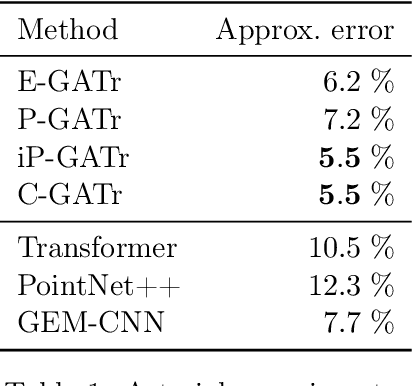
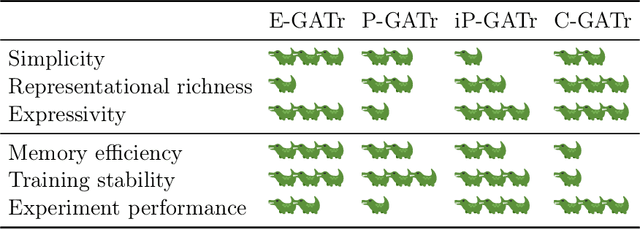
Abstract:The Geometric Algebra Transformer (GATr) is a versatile architecture for geometric deep learning based on projective geometric algebra. We generalize this architecture into a blueprint that allows one to construct a scalable transformer architecture given any geometric (or Clifford) algebra. We study versions of this architecture for Euclidean, projective, and conformal algebras, all of which are suited to represent 3D data, and evaluate them in theory and practice. The simplest Euclidean architecture is computationally cheap, but has a smaller symmetry group and is not as sample-efficient, while the projective model is not sufficiently expressive. Both the conformal algebra and an improved version of the projective algebra define powerful, performant architectures.
Geometric Algebra Transformers
May 28, 2023



Abstract:Problems involving geometric data arise in a variety of fields, including computer vision, robotics, chemistry, and physics. Such data can take numerous forms, such as points, direction vectors, planes, or transformations, but to date there is no single architecture that can be applied to such a wide variety of geometric types while respecting their symmetries. In this paper we introduce the Geometric Algebra Transformer (GATr), a general-purpose architecture for geometric data. GATr represents inputs, outputs, and hidden states in the projective geometric algebra, which offers an efficient 16-dimensional vector space representation of common geometric objects as well as operators acting on them. GATr is equivariant with respect to E(3), the symmetry group of 3D Euclidean space. As a transformer, GATr is scalable, expressive, and versatile. In experiments with n-body modeling and robotic planning, GATr shows strong improvements over non-geometric baselines.
EDGI: Equivariant Diffusion for Planning with Embodied Agents
Mar 22, 2023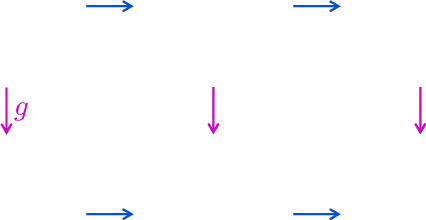

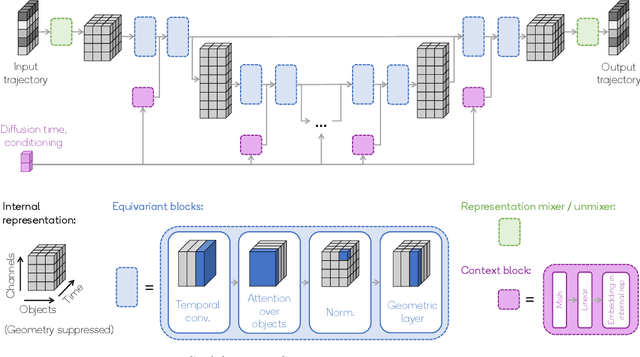
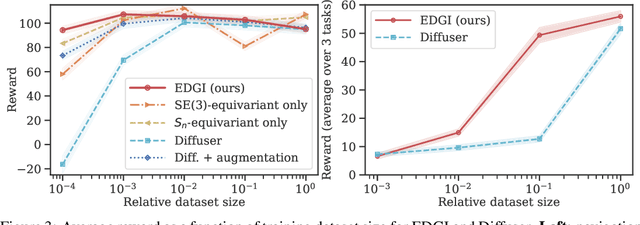
Abstract:Embodied agents operate in a structured world, often solving tasks with spatial, temporal, and permutation symmetries. Most algorithms for planning and model-based reinforcement learning (MBRL) do not take this rich geometric structure into account, leading to sample inefficiency and poor generalization. We introduce the Equivariant Diffuser for Generating Interactions (EDGI), an algorithm for MBRL and planning that is equivariant with respect to the product of the spatial symmetry group $\mathrm{SE(3)}$, the discrete-time translation group $\mathbb{Z}$, and the object permutation group $\mathrm{S}_n$. EDGI follows the Diffuser framework (Janner et al. 2022) in treating both learning a world model and planning in it as a conditional generative modeling problem, training a diffusion model on an offline trajectory dataset. We introduce a new $\mathrm{SE(3)} \times \mathbb{Z} \times \mathrm{S}_n$-equivariant diffusion model that supports multiple representations. We integrate this model in a planning loop, where conditioning and classifier-based guidance allow us to softly break the symmetry for specific tasks as needed. On navigation and object manipulation tasks, EDGI improves sample efficiency and generalization.
Rigid body flows for sampling molecular crystal structures
Jan 26, 2023Abstract:Normalizing flows (NF) are a class of powerful generative models that have gained popularity in recent years due to their ability to model complex distributions with high flexibility and expressiveness. In this work, we introduce a new type of normalizing flow that is tailored for modeling positions and orientations of multiple objects in three-dimensional space, such as molecules in a crystal. Our approach is based on two key ideas: first, we define smooth and expressive flows on the group of unit quaternions, which allows us to capture the continuous rotational motion of rigid bodies; second, we use the double cover property of unit quaternions to define a proper density on the rotation group. This ensures that our model can be trained using standard likelihood-based methods or variational inference with respect to a thermodynamic target density. We evaluate the method by training Boltzmann generators for two molecular examples, namely the multi-modal density of a tetrahedral system in an external field and the ice XI phase in the TIP4P-Ew water model. Our flows can be combined with flows operating on the internal degrees of freedom of molecules, and constitute an important step towards the modeling of distributions of many interacting molecules.
 Add to Chrome
Add to Chrome Add to Firefox
Add to Firefox Add to Edge
Add to Edge